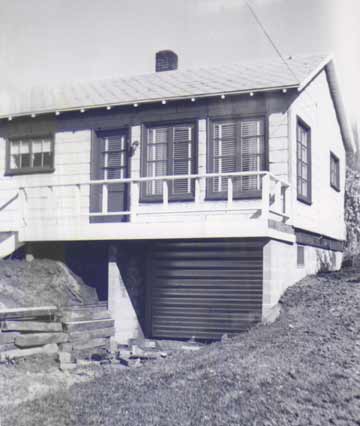 |
Previous Issues |
| Cedar Mill Community Website |
|
| About Cedar Mill News |
|
||||||
| Volume 4, Issue 7 | July
2006
|
|||||
|
 |
| Former Site of Mitchell's Shake Shop |
“Mitchell’s Shake Shop and the Bonny Slope Store both had burning embers on their roofs but equipment was there to put them out. The Shake Shop became headquarters for a Rec Cross Canteen unit, which later moved to the Bonny Slope Community Club,” wrote Frost. “If the 1951 fire was bad, the 1940 fire was worse!” she wrote. “Seven houses, eight other buildings, and 3000 acres were engulfed before it was stopped on Sunday, August 19.” One resident recalled, ”As the fire came close, the furniture was carried into the yard preparatory to moving it to Skyline Blvd. for safety. CCC boys sprayed water over the house from the roof and the house was saved but all of the furniture burned!
Violet Frost writes, “Although access roads have been slow in coming to the area, it is, nevertheless situated as it were at the doorstep of Portland. The era of Prohibition gave rise to a class of outlaws who distilled and sold spirits. They were able to successfully camouflage their illicit activities while being close to the ready metropolitan market.
“Mr Nelson had
a twinkle in his eye as he tells the story of ‘Frenchie’ an
intrepid moonshiner who hollowed out a tree stump, out of which
vapors from the still dissipated and mingled with odors of burning
stumps. Mr. Nelson recalls that he thought this stump was an incredibly
long time in “burning,” Frenchie’s
wares were peddled in Portland, along with vegetables that he
raised.”
Another moonshiner hid his still under one of the plank bridges
that crossed the creeks. “The logs were stacked to give the appearance
of solidity but they concealed a small room. To obtain his liquor, a customer
needed only to drive on the bridge, walk around to the trap door,
and pick up his supply.” Eventually the operations were exposed and
federal agents raided the illicit enterprises.
 |
| The former Bonny Slope Community Club is now a Romanian Christian
Church. Bonny Slope Park is to the right |
Although suburban development has erased the boundaries of early settlements, Bonny Slope was a self-sufficient community at one time. A small grocery store, a barber shop, a church and a malt shop were located at the intersection of Laidlaw and Thompson. The Bonny Slope Community Club and Bonny Slope Park were established on Thompson, and a general store operated in the building that still stands at the corner of South and Thompson up until the mid-90s. The country between Bonny Slope and Cedar Mill was forest and farms.
Local roads and other amenities were established as a result of petitions circulated on foot by residents who saw the need. W.H. McDaniel circulated a petition for the establishment of McDaniel Road in 1928. Less than a year later, a petition was filed for the establishment of Thompson Road, that would “provide a county road for a large area of farming lands now without a road, will afford an outlet toward the city of Portland…will furnish a road for children residing in said territory to reach school, and that said proposed road is necessary for the public travel and is a public necessity.” Laidlaw Road was finally approved in 1932.
 |
| Starter houses growing-the Hofferner family home getting an underground garage c. 1959 |
Most of the rest of the older roads in the area were dedicated when the area was platted in 1931 by Western Oregon Farms, with C.D. Bruun as developer. At the beginning of the Depression he subdivided into mostly two-acre lots, built inexpensive unfinished houses and sold them to people to finish as they wished. These were called “starter houses,” and according to longtime resident Jerry Hoffelner, “there’s one of those old houses inside most of the homes you see around here now.” All around Bonny Slope you can find these small homes and the larger homes that resulted from a succession of additions and improvements.
Violet Frost wrote, “People had mixed feelings about C.D. Bruun. Some deplored the inexpensive “starter’ houses as being unworthy of the view sites and claimed that they would attract an undesirable element. Many were glad in those depression days to have a roof over their heads that they could afford. Low down payment and easy terms were attractive, while others countered that the interest rate was excessive.”
Up until recent times, Bonny Slope had a reputation of being a rough area full of “hicks from the sticks.” Jean Hoffelner recalls that when she was attending Beaverton High School she told her friends that she lived “between Cedar Mill and Skyline,” to avoid admitting to being from Bonny Slope.
Now the proximity to
Portland, better roads, and the beauty of the natural area
has attracted some of the most expensive development in the region.
As a result of the Urban Growth Boundary, infill is turning every
two-acre property into a dozen large homes on small lots. How many
of these new homeowners even realize that they live in Bonny Slope?
Cedar Mill Business Association
Published monthly by Cedar Mill Advertising & Design
Publisher/Editor:Virginia
Bruce
503-629-5799
12110 NW West Rd
Portland, OR 97229